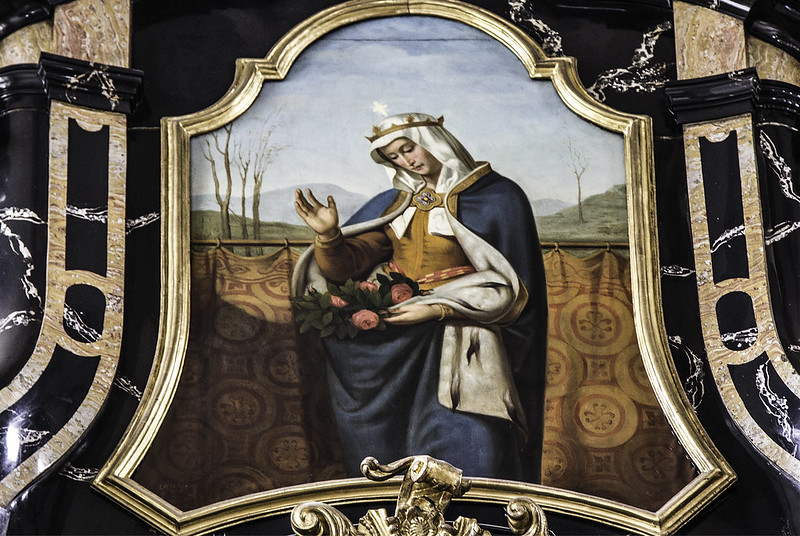CANONIZATION OF St. BARTOLO LONGO
– 19th October 2025
St. BARTOLO LONGO
– Feast Day 5th October
The Saint of the Holy Rosary
St. Bartolo Longo, a former Satanist who converted to Catholicism and became a fervent promoter of the Rosary, is associated with numerous miracles and extraordinary events. Most of these are connected to the Basilica of Our Lady of the Most Holy Rosary in Pompeii, which he helped build.
The miraculous cure of Fortuna Agrelli
The most famous miracle attributed to Bartolo Longo and the Virgin of the Rosary of Pompeii is the instantaneous healing of Fortuna Agrelli.
- The patient: In 1884, Fortuna Agrelli was a 12-year-old girl suffering from three separate, incurable diseases. Doctors had abandoned all hope of her recovery.
- The vision: After her family began praying the Rosary with her at the shrine in Pompeii, she experienced a vision of the Virgin Mary, seated on a throne with the Infant Jesus.
- The remedy: Mary, accompanied by St. Dominic and St. Catherine of Siena, instructed Fortuna to pray three novenas (27 days) in petition and three novenas (27 days) in thanksgiving.
- The result: Following Mary’s instructions, Fortuna was completely cured on May 8, 1884. This miraculous event is the origin of the 54-day Rosary novena.
Healings associated with the image of Our Lady of the Rosary
Other miracles began occurring soon after Longo’s restoration of a tattered painting of Our Lady of the Rosary, which became the centerpiece of the Pompeii shrine.
- The very day the image was unveiled to the public, a 12-year-old girl named Clorinda Lucarelli was completely healed of epileptic seizures.
- Following this first public miracle, reports of other healings, conversions, and special graces became increasingly common at the shrine.
The miracle of Pompeii’s rebirth
Bartolo Longo’s work in transforming the region of Pompeii is regarded as a miracle in itself.
- A “spiritual oasis”: Through his relentless efforts, Longo transformed a desolate, impoverished, and superstitious region near the ancient ruins into a flourishing “spiritual and social oasis”.
- Charitable works: The Marian shrine he founded served as a base for extensive social work, including orphanages and schools for the children of prisoners, providing them a chance for a new life.
- The desert blooms: When Pope Benedict XVI visited Pompeii in 2008, he summarized the extraordinary transformation by saying, “Who could have thought that a Marian Shrine of world-wide importance would have come into being here…Wherever God arrives, the desert blooms!”.
Miracles for his beatification and canonization
The Catholic Church recognizes miracles as a key requirement for beatification and canonization.
- Miracle for beatification: A miracle attributed to Bartolo Longo’s intercession—the 1945 healing of an Italian mother—was recognized in 1979, clearing the way for his beatification by Pope John Paul II in 1980.
- Dispensation for canonization: For his canonization in 2025, Pope Francis approved a dispensation, allowing it to proceed without the need for a second publicly recognized miracle. The exceptional nature of his life and the widespread devotion surrounding him were considered sufficient.
The miracle of his conversion
For many, the greatest miracle of Bartolo Longo’s life was his own conversion from a Satanic priest to a fervent Apostle of the Rosary.
- After a life of deep sin, depression, and occult practices, he was tormented by guilt and despair, feeling that his soul was beyond salvation.
- He recalled the words, “He who propagates my Rosary shall be saved,” and decided to dedicate his life to this cause.
- This resolution immediately brought him peace and led to his lifelong mission of spreading devotion to the Rosary.
Prayers to St. Bartolo Longo often focus on his remarkable conversion, his deep devotion to the Rosary, and his intercession for those in spiritual danger.
You can also use the prayer he composed himself, addressed to Our Lady of the Rosary.
Prayer for spiritual protection and conversion
St. Bartolo Longo, you who were led into darkness and despair, but through the intercession of the Virgin Mary, found new life and hope. Pray for us who are facing temptation and spiritual distress, that we may always turn to the Rosary as a source of strength and salvation. Intercede for all those trapped in error, that they may experience the mercy of Christ and the loving protection of Our Lady. Help us to imitate your fervor for the Holy Rosary, so that we may grow in holiness and overcome all evil. Amen.
Prayer for his canonization
This prayer can be used to ask for his final recognition as a saint of the Church.
Almighty God, we praise you for St. Bartolo Longo, a devoted apostle of the Rosary and an example of faith and charity. We thank you for his spiritual journey, his service to the Church, and his work for the marginalized in Pompeii. We pray for his canonization, so that he may be recognized as a saint for all to follow and seek his intercession. Amen.
St. Bartolo Longo’s prayer to Our Lady of the Rosary
This prayer, written by Longo himself, is a powerful expression of his devotion to the Rosary. You can find the full prayer in the referenced documents. It begins with the words, “O Blessed Rosary of Mary, sweet chain which unites us to God…” and concludes with “May you be everywhere blessed, today and always, on earth and in heaven. Amen”
ST. BARTOLO LONGO
– Feast Day 5th October
Who he was
- Born February 10, 1841 near Latiano (Brindisi), Italy.
- Died October 5, 1926 in Pompei, Italy.
- He studied law, became a lawyer, but during his university years drifted into occultism and spiritualist practices.
- After a profound conversion, he embraced Catholic faith again, joined the Third Order of Dominicans (Tertiaries) and devoted himself to the rosary and to devotion to Mary.
- He is often titled “Apostle of the Rosary” because he strongly promoted the rosary devotion.
Major works and legacy
- He founded and developed the Shrine of Our Lady of the Most Holy Rosary of Pompei in Pompei, Italy—turning a neglected site into a major pilgrimage shrine.
- He initiated various charitable works: orphans, education, helping the poor, promoting Marian devotion. –
- His life story is seen as a powerful example of conversion: from darkness (occultism) to light (Christian service). Many people find hope in that transformation.
Recognition in the Church
- He was beatified on October 26, 1980 by Pope John Paul II.
- His feast day is celebrated on October 5.
- There is strong movement toward his canonization (to be declared a saint) — some sources say he may be canonized in 2025.
Why he might matter to you
- If you have devotion to the rosary or Marian spirituality, he is a significant figure because he championed those devotions.
- His story offers encouragement to anyone who feels “too far gone” to return—showing that radical transformation is possible.
- If you are involved with or interested in the shrine at Pompei or Marian pilgrimage sites, his work is foundational.
Here’s a detailed timeline and key devotional writings of St. Bartolo Longo (1841–1926) — one of the greatest modern apostles of the Rosary.
LIFE TIMELINE OF BL. BARTOLO LONGO
| Year | Event |
| 1841 (Feb 10) | Born in Latiano, near Brindisi, Italy. His parents were devout Catholics. |
| 1858 – 1864 | Studied law at the University of Naples; became influenced by secularism and later involved in anti-Catholic circles and spiritualism. |
| 1864 – 1870 | Practiced law in Naples; at one point was even “ordained” a priest of a satanic sect — later deeply regretted. |
| 1871 – 1872 | Experienced depression and guilt; met Dominican Fr. Alberto Radente, who guided his confession and conversion back to the Church. |
| 1872 | Professed as a Dominican tertiary; took the name Fra Rosario (Brother Rosary). |
| 1873 – 1875 | Moved to the valley near Pompei; began catechizing peasants, teaching the Rosary devotion. |
| 1876 | Received a damaged image of Our Lady of the Rosary and restored it; began the devotion that spread rapidly. |
| 1879 – 1883 | Construction began on the Shrine of Our Lady of the Rosary of Pompei. |
| 1884 – 1887 | Founded charitable works for orphans and children of prisoners; established schools and workshops. |
| 1894 | Married Countess Marianna di Fusco (a widow and collaborator) with the Pope’s blessing; they lived chastely and dedicated their lives to service. |
| 1901 | Pope Leo XIII formally crowned the image of Our Lady of Pompei. |
| 1926 (Oct 5) | Died peacefully at Pompei, saying: “My only desire is to see Mary who has saved me and who will save me from the clutches of Satan.” |
| 1980 (Oct 26) | Beatified by Pope St. John Paul II, who called him “the man of the Madonna.” |
Bartolo Longo and How the Rosary Saved His Soul
SPIRITUAL LEGACY AND WRITINGS
“Supplication to Our Lady of the Rosary of Pompei” (1883)
His most famous prayer, recited worldwide every May 8 and first Sunday of October, especially at the shrine of Pompei.
It begins:
“O August Queen of Victories, O Sovereign of Heaven and Earth, at whose name the heavens rejoice and hell trembles, O glorious Queen of the Rosary, we, your devoted children, assembled in your temple of Pompei, pour out the fullness of our hearts…”
He called this prayer a “spiritual chain binding the world to Mary.”
Writings and Devotional Works
- “History of the Shrine of Pompei” (autobiographical, recounting miracles and conversions).
- “Novena to Our Lady of the Rosary of Pompei.”
- “The Fifteen Saturdays of the Rosary” (a devotion preparing for the Feast of the Rosary).
- “Manual of the Children of the Rosary.”
- Articles and pamphlets promoting the daily Rosary, family prayer, and moral reform.
Key Themes
- Mary as Mediatrix of grace through the Rosary.
- Total conversion and mercy for even the most hardened sinner.
- Social charity inseparable from prayer (he built schools, orphanages, workshops).
- Hope and joy in serving the poor under Our Lady’s protection.
Shrine of Our Lady of the Rosary of Pompei
- One of the most visited Marian shrines in Italy.
- Seat of the “Rosary Apostolate of Pompei,” continuing his mission of evangelization and service.
- Every year, millions of pilgrims gather for the Supplication prayers.
CANONIZATION OF St. BARTOLO LONGO
– 19th October 2025
Status and Key Dates
- Bartolo Longo was beatified by Pope John Paul II on 26 October 1980.
- On 25 February 2025, Pope Francis approved the favourable votes of the Ordinary Session of the Cardinals and Bishops of the Dicastery for the Causes of Saints, thereby advancing his cause toward canonization
- On 13 June 2025, during the Ordinary Public Consistory, it was announced that the date for his canonization would be Sunday, 19 October 2025.
- The official liturgical schedule lists Sunday 19 October 2025 at 10:30 a.m. in St Peter’s Square for the Mass and canonization ceremony of Bartolo Longo among other Blesseds.
Why It Matters
- Bartolo Longo’s canonization means he will move from “Blessed” to “Saint” in the Catholic Church.
- His life story is one of dramatic conversion (from secular/occult involvement to deep Catholic Marian devotion), making him a strong model of hope and mercy for many.
- As founder of the Shrine of Our Lady of the Rosary of Pompei and promoter of the Rosary, his canonization highlights both Marian devotion and lay-apostolic work.
What to Watch For/Prepare
- After canonization, liturgical calendars may officially list him as “Saint Bartolo Longo” and his feast day (currently 5 October) may be reaffirmed or celebrated more widely.
- Pilgrimages to his shrine, devotional materials (holy cards, medals) and popular devotion are likely to increase.
- Some sources note the miracle(s) attributed to his intercession have been approved (a necessary step toward canonization).
Miracle(s) and Note on the Process
- For his beatification (26 October 1980), a miraculous healing was recognized: for example, sources mention the healing of a girl with leukemia in 1979 attributed to his intercession.
St. Bartolo Longo is associated with numerous miracles, most notably the miraculous healing of Fortuna Agrelli after she prayed to Our Lady of the Rosary in his newly built Pompeii shrine. Another significant “miracle” is the profound, life-altering conversion of Longo himself from a Satanist to a devoted promoter of the Rosary, which ultimately led to the restoration of the town of Pompeii through charitable works and social services.
Miracles associated with St. Bartolo Longo
- Fortuna Agrelli’s healing:
In 1884, a young girl named Fortuna Agrelli, who was afflicted with three incurable diseases, was miraculously healed after praying to the image of Our Lady of the Rosary in the shrine founded by Longo.
- Conversion of Bartolo Longo:
Longo’s dramatic conversion from a former “high priest” of Satanism to a devout Catholic is considered a major miracle in itself. He reportedly experienced a profound mystical experience and a complete change of heart after being guided by a Dominican priest to pray the Rosary.
- Restoration of Pompeii:
Through his work with his wife, Countess Mariana di Fusco, Longo established social works around the shrine, including an orphanage and a house for the children of prisoners. This transformation of a poverty-stricken area into a thriving community is described as a miraculous work.
- Miracles at the shrine:
Miracles were reported to have begun occurring at the shrine shortly after it was established, leading to it becoming a major pilgrimage site and being referred to as the “Italian Lourdes”.
Due to his own extraordinary life and conversion, St. Bartolo Longo’s intercession is sought for specific graces, particularly those related to repentance, spiritual warfare, and the power of the Rosary. He is often petitioned for the following favors:
For conversion and repentance
St. Bartolo Longo went from being a satanic high priest to a fervent apostle of the Rosary. His life is a powerful testament to the boundless mercy of God, and for this reason, he is invoked for the conversion of those lost in sin or spiritual darkness.
- Hope for those in despair: His journey out of darkness gives hope to those who feel they are beyond redemption.
- Intercession for family members: Like St. Monica for St. Augustine, Bartolo Longo’s family prayed for his return to the faith. He is a powerful intercessor for families with loved ones who have fallen away from the Church
For protection from evil and the occult
Having once been deeply involved in occult practices, Bartolo Longo is a powerful intercessor for those who are struggling with or seeking freedom from evil influences, spiritism, and witchcraft.
- Protection against demonic influence: He can help those who are experiencing temptation, fear, or spiritual bondage.
- Freedom from the occult: He can intercede for those who have been involved in the occult or new-age practices and are now seeking to turn back to God.
For devotion to the Rosary
The Rosary was the instrument of Bartolo Longo’s salvation. He is a patron for all who seek to grow in devotion to the Rosary and experience its spiritual power.
- Renewed devotion: He can help those who struggle with praying the Rosary to find peace, focus, and spiritual insight.
- Understanding the Rosary’s power: As an apostle of the Rosary, he can intercede for a deeper understanding of its mysteries and its effectiveness against evil.
For the poor and abandoned
Bartolo Longo dedicated his later life to charitable works, especially for the children of prisoners and orphans in Pompeii.
- Charitable works: He can be invoked for the success of works of charity and social progress, particularly those focused on caring for the marginalized.
- Assistance for orphans and abandoned children: As the founder of orphanages, he is a compassionate intercessor for the needs of abandoned children and their caretakers.
For physical and mental healing
While no longer required for his canonization, a miracle of healing was attributed to his intercession for his beatification. He is petitioned for both physical and mental ailments, especially those related to despair, anxiety, and psychological distress.
- Miraculous cures: Many healings have been associated with his work at the Shrine of Pompeii and his intercession.
- Relief from mental illness: His own struggles with paranoia, depression, and despair make him a compassionate intercessor for those dealing with similar mental health issues.
St. Bartolo Longo actively promoted several other devotions and prayers rooted in his Catholic faith
In addition to the Holy Rosary, St. Bartolo Longo actively promoted several other devotions and prayers rooted in his Catholic faith and guided by his experience of conversion. His zeal was centered on Mary, but also extended to other practices that helped him grow in holiness and share his faith with others.
The 54-Day Rosary Novena
- Origin: This novena is one of Longo’s most famous contributions. He composed it in 1884 following the miraculous cure of a young girl, Fortuna Agrelli.
- Structure: It consists of praying three novenas (27 days) of the Rosary in petition for a specific intention, followed immediately by three novenas (27 days) of the Rosary in thanksgiving, for a total of 54 days.
- Purpose: Longo created this novena specifically for “the most desperate cases” and as a testament to the power of perseverance in prayer.
The Supplication to the Queen of the Holy Rosary
- Purpose: This powerful prayer, composed by Longo, is recited by thousands around the world at noon on May 8 and on the first Sunday of October each year.
- Content: The prayer is a heartfelt plea to the Virgin Mary under her title of Queen of the Rosary of Pompeii, asking for her protection and mercy.
- Legacy: The supplication became a popular devotion after its composition in 1883, and its widespread success led to the formal approval of the devotion by Pope Leo XIII.
Frequent Confession
- A personal practice: After his return to the Catholic faith, Longo went to confession frequently, sometimes twice a week.
- An example to others: He promoted the Sacrament of Reconciliation as a vital way to overcome sin and grow in holiness, leading many others to embrace this practice. His emphasis on confession is particularly poignant given his history of despair and guilt over his past involvement in Satanism.
The Universal Call to Holiness
- Lay spirituality: Longo was a married layman who pursued holiness in his daily life. With his wife, Countess Mariana di Fusco, he managed the charitable works of the Pompeii sanctuary while living in chastity by mutual agreement.
- Charity and service: By promoting institutions like orphanages and schools for the children of prisoners, Longo demonstrated that devotion to Mary is inseparable from practical charity and service to the poor. This was central to his mission.
Marian Confraternities
- Building community: Longo founded a “Confraternity of the Rosary” to bring people together for prayer and spiritual growth.
- Educating the faithful: The confraternity’s mission was to help re-educate people about the truths of Catholicism through the mysteries of the Rosary.
What was the significance of Bartolo Longo and his wife’s chaste marriage?
The significance of St. Bartolo Longo and Countess Mariana di Fusco’s chaste marriage lies in its powerful witness to holiness in lay life and its crucial role in protecting their charitable mission from scandalous gossip
A defense against slander
By the time of their marriage, Bartolo Longo and the widowed Countess di Fusco had already been collaborating for years on their charitable and spiritual projects in Pompeii.
- Widespread gossip: This close working relationship between a prominent lawyer and a wealthy widow attracted cruel and unfounded gossip.
- Pope Leo XIII’s advice: To silence the rumors that threatened to discredit their important mission, Bartolo and the Countess sought the advice of their friend, Pope Leo XIII, a great devotee of the Rosary.
- The solution: The Pope counseled them to marry. As Longo recalled, the Pope advised, “Lawyer, you are free; Countess, you are a widow; get married and no one can say anything against you”.
- The chaste union: The couple followed his advice and entered into a chaste marriage, also known as a Josephite marriage, forgoing a physical relationship to dedicate their combined love and energy to God and their charitable works.
A model of lay holiness
The couple’s chaste marriage was a significant sign that an individual could attain great holiness within the lay state, living out their faith through active charity and a consecrated life.
- Holiness for the laity: For many at the time, a chaste marriage was an extraordinary example of holiness in everyday life. Longo and the Countess showed that living a life rooted in the Gospel was not exclusively for priests or nuns.
- A “spiritual parenthood”: Their union, free from sexual relations, was defined by a spiritual parenthood. Together, they oversaw the care of orphans and the children of prisoners, pouring their lives into their charitable works as if the children were their own.
- Mission-focused partnership: The marriage consecrated their lives to a shared mission of serving the poor and promoting the Rosary, demonstrating that a deep, loving relationship could be entirely focused on good works.
An example of God’s transformative power
For Bartolo Longo specifically, his past as a satanic priest made his later life of profound chastity and charity a powerful example of God’s transformative power. His life showed that no one is beyond God’s mercy, and even those who have committed great sins can be called to an extraordinary level of holiness and purity.
St. Bartolo Longo, with his wife Countess Mariana di Fusco, established a “city of charity” around the Sanctuary of Our Lady of the Rosary in Pompeii. The charitable works they founded became a tangible expression of their faith and were dedicated to transforming the lives of the most marginalized people in the desolate region.
Caring for the children of prisoners
One of the most radical and socially progressive aspects of their work was their commitment to the children of convicted criminals.
- Social stigma: In the 19th century, these children were often ostracized by society and faced a bleak future, with many assuming they would become delinquents.
- Breaking the cycle: Longo and the Countess understood the need to break this cycle of poverty and despair through education, compassion, and vocational training.
- Dedicated institutes: In 1892, they founded an institute for the sons of prisoners, and in 1922, they established another for the daughters of prisoners. These institutions provided care, education, and a chance for a new life.
Orphanages and schools
In addition to their work with prisoners’ children, the couple established numerous other institutions to care for the poor and abandoned.
- Orphanage for girls: In 1887, Longo founded an orphanage for girls, run by the Dominican Sisters of the Rosary of Pompeii, a new order of women religious he created.
- Institutes for boys: He established an institute for boys, which was entrusted to the care of the Brothers of the Christian Schools.
- Comprehensive education: These schools provided not only academic but also technical education, ensuring the children could learn a trade and become productive members of society.
A thriving city
Beyond the specific institutions, Longo’s work fostered the development of an entire community where there had previously been only malaria and desolation.
- Foundational infrastructure: He and the Countess financed and supervised the construction of essential public infrastructure, including a post office, a telegraph office, a hospital, a train station, and houses for workers.
- “Field hospital” for the poor: Through these and other social practices, the Pompeii shrine became a “field hospital” for the poor, a concrete expression of the Gospel’s message of love.
Divine inspiration
Longo’s vision for charity was driven by his faith and rooted in a theological understanding of love. As one priest noted, “Christian social works are not born of natural philanthropy but from the love of God poured into the believer’s heart”. The success of his works demonstrates how faith, when met with an open heart, can accomplish great things.
St. Bartolo Longo and Countess Mariana di Fusco faced numerous significant challenges in their charitable work, from the financial instability of their projects to spiritual warfare and slander. These difficulties spanned the full course of their efforts to transform the desolate region of Pompeii into a thriving “city of charity”.
Financial and logistical challenges
- Constant need for funds: Longo and the Countess were continually in need of money to construct and maintain their ambitious projects, which included the sanctuary, orphanages, schools, a hospital, and other infrastructure.
- The Countess’s limited means: Although Countess di Fusco came from a noble background, she had little ready cash due to her late husband’s debts. Her initial donation of land was a critical first step, but it did not provide the ongoing resources necessary for the massive undertakings.
- Constant begging: Longo was forced to travel extensively and tirelessly beg for funds, a task that drew public scorn and frustration. This constant need for financial support was a persistent burden throughout his life.
- Reliance on Providence: Despite these immense financial needs, they always trusted in God’s Providence, often starting projects with insufficient funds and relying on the generosity of benefactors inspired by the work.
Persecution and slander
- Malicious rumors: The close working relationship between the bachelor Longo and the widowed Countess prompted widespread gossip and slander, which threatened to discredit their mission.
- Church opposition: Some in the Church were initially skeptical of their work and the reports of miracles, with a few openly opposing their efforts. Their chaste marriage, conducted at the advice of Pope Leo XIII, was necessary to protect their reputation and silence these rumors.
- Skepticism from elites: Their work in Pompeii drew skepticism from certain intellectual circles and the nobility, who sometimes ridiculed the religious “superstition” and saw their efforts as beneath them. When Longo was nominated for a Nobel Peace Prize, he was ignored by the Nobel committee partly because of his religious ties.
- Enduring hardship: As Pope John Paul II noted, Longo “endured tribulations and slander in silence, passing through a long Gethsemane,” always trusting in Providence and remaining obedient to the Church.
Spiritual battles
- Longo’s personal demons: Longo was relentlessly tormented by his past, experiencing deep depression, guilt, and diabolical visions. The devil continuously tried to convince him that his soul was beyond salvation. This spiritual battle was a constant feature of his life, even after his conversion.
- Combating local paganism: The region of Pompeii was spiritually desolate, with the rural population steeped in superstition and occult practices—the very practices Longo had embraced in his youth. A major challenge was not only building the physical infrastructure but also re-catechizing and converting the local population to an orthodox Catholic faith.
Social and political opposition
- Hostile political climate: Longo’s work began during a period of intense anti-Catholic sentiment in Italy, fueled by rising nationalism and anticlerical movements. Universities were hostile to the Church, and many of Longo’s professors and peers were fiercely anti-Catholic.
- Addressing social ills: Their work to support the children of prisoners was considered radical at the time. The widespread prejudice against these children added another layer of social difficulty, which they combated with compassion and charity.
Stay connected — subscribe today
https://www.youtube.com/@st.michaelusa
SIGN UP SO YOU CAN GET A BLESSING !
https://stmichaelcenter.flocknote.com/StMichaelCenter
FOLLOW US ON FACEBOOK !
https://www.facebook.com/StMichaelCenter/


 https://www.youtube.com/shorts/ND6Wh99nXic
https://www.youtube.com/shorts/ND6Wh99nXic









